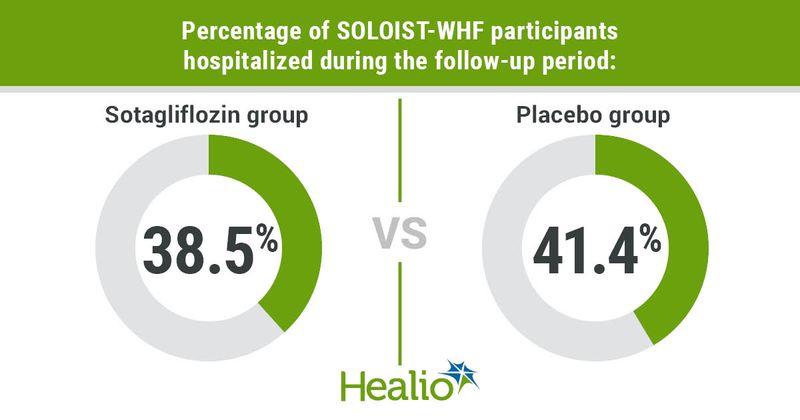Sotagliflozin reduces deaths, time spent in hospital for some patients with diabetes
Sotagliflozin increased the number of days alive and out of the hospital compared with placebo among patients with type 2 diabetes at high risk for intermittent hospitalization due to worsening heart failure, data show.
The findings are from a new prespecified analysis of participants enrolled in the Effect of Sotagliflozin on Cardiovascular Events in Patients with Type 2 Diabetes Post Worsening Heart Failure, or SOLOIST-WHF, trial.

Previously, the SOLOIST-WHF trial showed that sotagliflozin reduced cardiovascular deaths as well as hospitalizations and urgent visits for heart failure among patients with diabetes who were recently hospitalized for worsening heart failure, Michael Szarek, PhD, MS, a visiting professor in the division of cardiology at the University of Colorado School of Medicine, told Healio Primary Care.
In the current analysis, Szarek and colleagues examined days alive and out of the hospital (DAOH) among 1,222 older adults from 32 countries, about one-third of them women, who received 200 mg of sotagliflozin (with the potential to increase the dose to 400 mg) daily or placebo.

“We knew from the primary endpoint [of SOLOIST-WHF] that sotagliflozin reduced total occurrences of hospitalization for heart failure, and there was a favorable trend in all-cause mortality,” Szarek told Healio Primary Care. “But from these results we did not know if this would translate to extending DAOH. In addition, few prior studies have shown a favorable effect of treatment on DAOH because it includes hospitalizations for any reason, many of which would not necessarily be expected to be influenced by a given treatment.”
In the new prespecified analysis, patients were followed for a median of 9 months. The researchers wrote that 38.5% of the sotagliflozin group and 41.4% of the placebo group were hospitalized at least once. In the sotagliflozin group, 16.3% of patients were hospitalized more than once compared with 22.1% in the placebo group. The researchers reported 64 deaths in the sotagliflozin group and 76 deaths in the placebo group.
The DAOH rate was 3% higher in the sotagliflozin group compared with the placebo group (rate ratio = 1.03; 95% CI, 1-1.06). This difference was largely attributable to a decline in the rate of days dead (rate ratio = 0.71; 95% CI, 0.52-0.99) rather than by a dropoff in the rate of days spent in the hospital regardless of the reason, according to the researchers. The findings translated to more days alive and out of the hospital (91.8 vs. 88.9 days), fewer days deceased and out of the hospital (6.3 vs. 8.9 days) and fewer days in the hospital (1.9 vs. 2.2 days) for every 100 days of follow-up in the sotagliflozin group compared with the placebo group.
“The results were not necessarily expected even given the positive primary endpoint results,” Szarek said in the interview.
The findings support clinicians initiating an SGLT2 inhibitor as soon as possible after hospitalization, according to Szarek.
“Not only is reducing hospitalizations for any cause a clear benefit to patients, but the COVID-19 pandemic also illustrates the benefits to the health care system in keeping patients out of the hospital in general,” he said.
